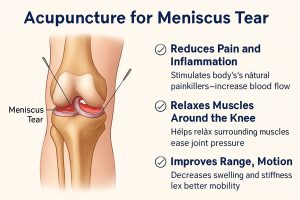What's new
Flow Japanese Acupuncture Tokyo talks about Meniscus Tear Treatment2025.08.08
 What Is a Meniscus Tear?
What Is a Meniscus Tear?
The meniscus is a piece of cartilage that cushions and stabilizes your knee joint.
A meniscus tear often occurs due to:
- Sudden twisting (sports injuries)
- Age-related degenerationCommon symptoms:
- Pain
- Swelling
- Stiffness
- Catching or locking of the knee
 How Acupuncture Can Help a Meniscus Tear
How Acupuncture Can Help a Meniscus Tear
Acupuncture does not “repair” the cartilage, but it can greatly support the healing process and symptom management.
 1.
1.
Reduces Pain and Inflammation
- Acupuncture stimulates the body’s natural painkillers (endorphins)
- Increases blood flow to the knee, which helps reduce inflammation
 2.
2.
Relaxes Muscles Around the Knee
- Tight thigh or calf muscles can pull on the knee joint and worsen pain
- Acupuncture helps relax surrounding muscles, easing joint pressure
 3.
3.
Improves Range of Motion
- With less pain and inflammation, mobility improves
- Less stiffness = faster rehab, especially when combined with physical therapy
 Common Acupuncture Points for Meniscus Injury
Common Acupuncture Points for Meniscus Injury
Acupuncturists usually needle a combination of local and distal points:
 Local Points (Around the Knee)
Local Points (Around the Knee)
- Xiyan (ST35) – Just below the kneecap
- Dubi (ST35) – Beside the patella
- Xuehai (SP10) – Above the knee on the inner thigh
- Ashi Points – Tender spots around the injury
 Distal Points (To help from a distance)
Distal Points (To help from a distance)
- Zusanli (ST36) – Below the knee on the shin
- Sanyinjiao (SP6) – Inner leg, supports circulation and tissue healing
- GB34 – Helps with tendon and ligament support
These points are chosen based on individual assessment—some may include electrical stimulation (electro-acupuncture) for deeper therapeutic effect.
Flow Japanese acupuncture clinic is an English friendly clinic. English-speaking staff is available. Please feel free to call us.
03-6453-6376

